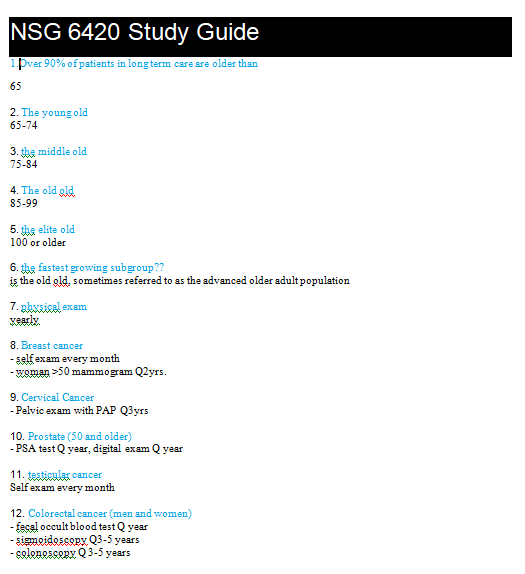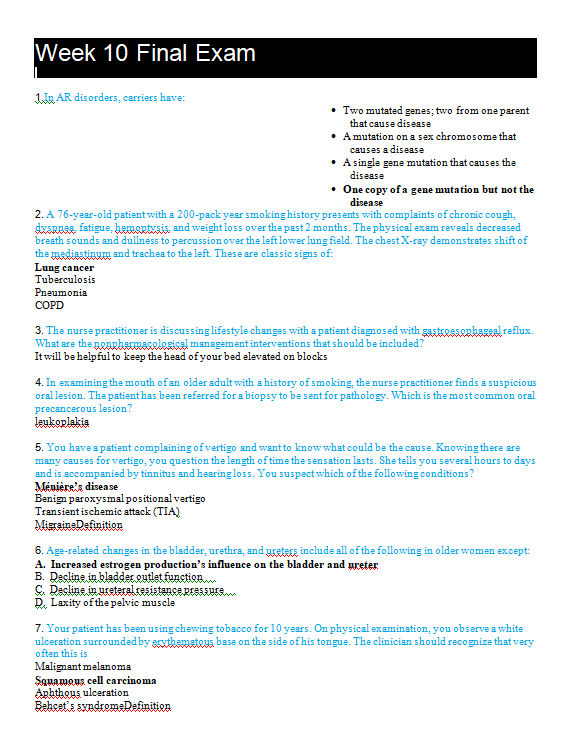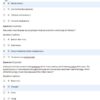Description
NSG 6420 Final Exam Study Guide – Question with Answers – South University
(450 Question and Answers)
- Over 90% of patients in long term care are older than
- The young old
- the middle old
- The old old
- the elite old
- the fastest growing subgroup??
- physical exam
- Breast cancer
- Cervical Cancer
- Prostate (50 and older)
- testicular cancer
- Colorectal cancer (men and women)
- Skin Cancer
- oral cancer
- Oral cancer
- Bone density
- Vision
- Immunnizations
- Genetic Theory
- Immunity Theory
- Cross linkage theory
- free radical theory
- KATZ
- Stages of Alzheimer’s: Stage 1
- Stages of Alzheimer’s Stage 3
- what can happen to dentures with aging
- Stages of Alzheimer’s Stage 2
- Older adults need an increased amount of what nutrients
- Diminished senses can lead to what?
- pre albumin
- Albumin
- total lymphocyte count
- geriatric failure to thrive
- maintaining appropriate levels of physical activity can decrease what?
- Relocation syndrome
- Home modifications that can help prevent falls
- presbyopia
- what are some things to be aware of with a decrease in the sense of touch
- what are some common drugs older adults take OTC
- age related changes that can potentially affect absorption of drugs orally
- Age related changes that affect drug distribution
- older adult changes in drug metabolism
- excretion of drugs as it related to aging
- normal creatinine clearance for men and women
- Common adverse drug effects on the elderly
- when preforming a medication assessment of an older adult what are some drugs the nurse should ask if the pt is taking
- BEERS
- depression and the older adult
- what are some signs of depression the the older adult
- drugs for depression
- without TX what can depression result in
- dementia
- dementia
- delirium
- some of the factors that can cause delirium
- how often should the older adult be in the sun
- how much calcium should the older adult have
- Baby boomers
- what are some psychosocial concerns for the older adult
- Normal physical changes of older adults: General status
- Normal physical changes of older adults: integument
- functional aging
- Normal physical changes of older adults: musculoskeletal
- Normal physical changes of older adults: neurologic
- risk factors for alzheimer’s
- Normal physical changes of older adults: cardiopulmonary
- Normal physical changes of older adults: Genitourinary
- Spices Framwork
- seborrheic keratosis
- seborrheic dematitis
- cherry anginoma
- actinic lentigines
- actinic purpura
- bruising
- arcus senilis
- blepharitis
- what are some interventions to promote sleep
- stress incontinence
- urge incontinence
- overflow incontinence
- Mixed incontinence
- functional urinary incontinence
- factors contributing to urinary incontinence
- Interventions for incontinence
- describe some sleep changes in the older adult
- things to be aware of when implementing pain interventions and the elderly
- Iron deficiency anemai
- ACD
- ACD
- GINA Bill
- Physiological changes of aging
- X-linked Dominant
- Autosomal Recessive
- Dysmorphology
- First Step for family genome assessment?
- Health History includes?
- Biotransformation(metabolism)
- First symptoms of HIV?
- Cardiovascular risk factors
- Blood sugar screening
- S1
- S2
- S3
- S4
- Posterior drawer test
- Systolic Murmurs
- Murmur Red Flags
- Signs of Aortic Stenosis nsg 6420 final exam
- mitral valve prolapse (MVP)
- Most common oral precancerous lesion?
- Frozen Shoulder (Adhesive Capsulitis)
- MVP sxs
- Moderate-intensity statin therapy
- Moderate to high intensity statin therapy
- Most accurate diagnosis for pancreatitis?
- When is Niacin used?
- Grave’s disease
- H. pylori gastritis: treatment
- Anterior Drawer Test
- Presbycusis
- How often do you check PSA levels?
- Tinea Capitis Treatment
- Keratitis
- Bacterial conjunctivits
- Allergic conjunctivitis
- Viral conjunctivitis
- Amaurosis fugax
- Most common cause of eye redness?
- Warnings for eye redness
- clinical manifestations of UTI
- Isolated Systolic HTN in elderly
- Screen for lipids
- Mitral Stenosis
- Hypertensive reinopathy
- Diabetic reinopathy
- cerumen impaction
- Atopic disorders mediated by IgE with a histamine response. Histamine response is:
- CURB 65
- Which findings are not considered normal age related?
- Common skin cancer found on the nose?
- Centor criteria for GABHS bacterial pharyngitis
- What are the signs and symptoms of Impingement syndrome?
- Ischemic Heart Disease
- Chronic stable angina
- Prinzmetal angina
- Unstable Angina
- Nephrolithiasis
- pyelonephritis
- Gross hematuria + flank pain + palpable mass
- BPH
- Proteinuria
- stress urinary incontinence (SUI)
- #1 compliant of OA?
- 20yo female with pain, tenderness, decrease ROM at neck, shoulder, and medial knee:
- Ligament injury, “give-away”, “pop”
- De Quervain’s tendonistis
- Osteoarthritis
- Differential diagnosis for knee pain?
- Ottawa ankle rules (5 things)
- Systemic Lupus Erythematosus (SLE)
- Rotator Cuff Muscles (shoulder joint stabilizer)
- subacromial bursitis
- back pain: red flags
- Subarachnoid hemorrhage (SAH)
- First line of therapy for acute gout?
- Migraine Headache
- tension headache
- Phenytoin (Dilantin)
- Dementia Symptoms
- Subdural hematoma in elderly
- DPP-4 inhibitor
- MOA of metformin.
- GLP-1 agonists MOA
- Thiazolidinediones
- Sulfonylureas
- Pancreatitis
- Pleurisy
- Left upper quadrant pain
- Right upper quadrant pain
- Hypersplenism
- Cellulitis
- Actinic keratoses
- Basal Cell Carcinoma
- Squamous Cell Carcinoma
- Vitiligo
- Major signs of melanoma
- A group of furuncles?
- Type 2 Diabetes
- Men have faster and more efficient biotransformation of drugs and this is thought to be due to:
- The major impact of the physiological changes that occur with aging is :
- The cytochrome p system involves enzymes that are generally Inhibited by drugs :
- Functional abilities are best assessed by :
- Iron Deficiency Anemia (IDA) is classified as a microcytic, hypochromic anemia. This classification refers to which of the following laboratory data?
- When interpreting laboratory data, you would expect to see the following in a patient with Anemia of Chronic Disease (ACD) :
- The pathophysiological hallmark of ACD is:
- The main focus of treatment of patients with ACD is:
- In addition to the complete blood count (CBC) with differential, which of the following laboratory tests is considered to be most useful in diagnosing ACD and IDA?
- Symptoms in the initial human immunodeficiency virus (HIV) infection include all of the following except: nsg 6420 final exam
- Essential parts of a health history include all of the following except:
- Which of the following clinical reasoning tools is defined as evidence-based resource based on mathematical modeling to express the likelihood of a condition in select situations, settings, and/or patients?
- The first step in the genomic assessment of a patient is obtaining information regarding:
- In autosomal recessive (AR) disorders, individuals need:
- In AR disorders, carriers have:
- A woman with an X-linked dominant disorder will:
- According to the Genetic Information Nondiscrimination Act (GINA):
- Which of the following would be considered a “red flag” that requires more investigation in a patient assessment?
- Vestibular
- Vestibular Function
- Your 2-year-old patient shows facial features, such as epicanthal folds, up-slanted palpebral fissures, single transverse palmar crease, and a low nasal bridge. These are referred to as:
- In order to provide a comprehensive genetic history of a patient, the NP should:
- Vestibular Dysfunction
- 5 Anatomical Sites for Vestibular Lesions
- Reasons for vestibular dysfunction
- Dysequilibrium
- Nystagmus
- Oscillopsia
- Presbystasis
- ***Vertigo
- OT Scope of Practice
- Entry Level Practitioners MUST have:
- Entry Level Practitioner Vestibular Rehab Interventions
- Vestibular Disorders
- Objective Diagnostic Vestibular testing
- Peripheral Vestibular Disorders
- Central Vestibular Disorder
- Systemic Disorders
- Physician Subspecialties
- Common Signs of Vestibular Problem
- Vestibular labyrinth is located within what portion of the skull?
- The semicircular canals within our inner ear are filled with what substance?
- Peripheral Vestibular System
- The bony labyrinth is filled with what type of fluid?
- The membranous labyrinth contains:
- What is the job of the 3 semicircular canals?
- What is the job of the 2 otolithic organs (Saccule and Utricle)
- Inside the Otolithic Membrane = Macula (A receptor)
- Semicircular Canals & Co-Pairs
- Vestibulo-Ocular Reflex (VOR) is an eye mvmt made in response to mvmt of which body part?
- *Peripheral Vestibular System feeds what part of the Central Vestibular System?
- Somatosensory System feeds what part of the Central Vestibular?
- Gaze Stabilization
- *Visual/Oculomotor System feeds what part of the Central Vestibular System?
- Gaze Stabilization is achieved by:
- Central Oculomotor Skills that contribute to Gaze Stabilization:
- Central damage
- Peripheral Damage
- Benign Paroxysmal Positional Vertigo (BBV) is a common disorder of the:
- Common Disorders of the Peripheral Vestibular System:
- Nausea/Vomiting
- Neurological symptoms
- Auditory Changes
- Interventions for Disequilibrium
- BPPV
- Vestibular Neuritis
- How to assess for BPPV:
- Disorders of the Central Vestibular System
- Ischemic Diseases
- Progressive Disorders
- Wallenberg’s Syndrome
- OT Evaluation Skills for Vestibular Rehab
- OT Interventions for Vestibular Rehab
- What interventions resolve BPPV, eliminate vertigo and restore functional independence?
- Epley Maneuver
- Brandt-Daroff Exercises
- Contraindications to performing Dix-Hallpike Test
- What are the steps in treating BPPV?
- Dix-Hallpike (Assessment)
- Intervention activities for Disequilibrium:
- Examples of disequilibrium movement intervention activities:
- Goal directed activities for disequilibrium
- 3 Normal Balance Strategies
- Balance Interventions
- Vestibular Hypofunction
- Interventions for vestibular hyopfunction
- Goal for vestibular hypofunction interventions
- Vestibular Hyperfunction
- Interventions for vestibular hyperfunction:
- Goal for vestibular hyperfunction
- Activities for HYPOfunction
- Activities for HYPERfunction
- Interventions for Vestibular Ocular Dysfunction
- Goal for vestibular ocular dysfunction
- Visual-Vestibular Interaction Interventions
- Sharp Purser Test
- How to administer the Sharp Purser Test
- Positive Sharp Purser Test
- Negative Effects of Chronic Pain
- Pain Perception
- Pain Perception
- What does OT address in pain perception?
- What do OTS address for pain perception?
- Nociceptive Pain
- Nociceptive Pain
- Neuropathic Pain
- Neuropathic pain
- Biopsychosocial Model of Pain
- Biopsychosocial Model of Pain
- Loeser and Fordyce Four Pain Domains
- Evaluation of Pain
- Theoretical Approaches to Pain Management – Behavioral
- Methods for Pain Management – Behavioral
- Methods for behavioral pain management
- Operant Strategies for Pain Management
- Cognitive Behavioral Strategies
- Cognitive Behavioral Strategies
- Volar plate contracture (PIP Flexion contracture)
- Rupture of FDP
- Nonfixed position OT treatment
- Fixed position OT treatment
- What is swan neck deformity characterized by?
- Rehab Protocol for Tendon Repair
- Three types of Extensor Tendon Protocols
- Three types of Flexor Tendon Protocols
- Initial Splints for Tendon Repairs
- Tendon Repair Protocol Phases
- Cumulative Trauma Disorders
- Three Stages of CTD
- TX of CTD
- Common CTDs
- Common Peripheral Nerve Injuries
- Tinel’s Sign
- Phalen’s Test
- Reverse Phalen’s
- Positive Phalen’s Test-Reverse Phalen’s
- Radial Nerve Innervates what muscles?
- Median nerve innervates what muscles?
- Ulnar nerve innervates what muscles?
- Three Response Variables
- Pyschosocial Concerns with Disability
- Self-determination
- Interdependence
- Disability Vs. Chronic Illness
- What factors contribute to a person’s ability to adapt?
- Values and Beliefs that guide psycho social aspects of disability
- Kubler Ross Loss Stages
- Short term psychosocial reactions reactions
- Intermediate psychosocial reactions
- Longterm psychosocial reactions
- Adaptive responses
- Maladaptive responses
- Shock
- TX approaches for shock
- Defensive Retreat or Denial
- Tx approaches for Defensive Retreat or Denial
- Depression or Mourning
- TX approaches for Depression or Mourning
- Suicidal ideation
- Regression
- Personal Questioning and/or Anger
- TX approaches for Personal questioning/Anger
- Integration and Growth
- TX approaches for Integration and Growth
- Disability communities
- Disability rights movement
- Independent living (IL) movement
- Independent Living Centers (ILC)
- Self-advocacy
- Self-advocacy Intervention
- Ombudsman
- Employee assistance program
- Legal aid societies
- Teaching Self-Advocacy to Support Adaption to Disability
- Pain Definition
- Acute pain
- Chronic Pain
- Mixed Pain
- Biopsychosocial Model – Loeser and Fordyce: 4 Pain Domains
- Evaluation of Pain (Subjective) nsg 6420 study guide
- Evaluation of pain (objective)
- Behavioral Approaches to Pain Management
- Physical Agent Modalities (PAMS)
- Operant Strategies (Behavioral)
- Secondary Gains (Operant)
- How do OTs use Operant Strategies?
- Cognitive Behavioral Techniques
- MOHO Approaches to Pain Management
- Chronic pain may be complicated with:
- Graded activities for Chronic Pain nsg 6420 final exam
- Quota Programs and Chronic Pain
- Relaxation Training
- Biofeedback
- Other Pain Management Interventions
- Congenital Amputations nsg 6420 study guide
- Acquired Amputations
- UE Amputations
- LE Amputation
- Levels of UE Amputation
- Levels of LE Amputation
- Factors that Impact Rehab
- Phantom limb
- Phantom Sensation
- Pre-Prosthetic OT
- Immediate Post Surgical Fitting
- Sensory Deficits & Interventions
- Hypersensitivity
- Desensitization
- Mandy Case Study OPHII Scale
- Mandy Case Study WRI Scores
- Mandy’s Case Study narrative slope:
- OPHI-II
- WRI
- Mandy Case Study LTGs
- OT Intervention for Mandy Case Study
- Non-adherent Behavior
- Underlying Meaning of non-adherent
- Therapeutic responses to non-adherent behavior
- Manipulative-Dependent Behavior nsg 6420 study guide
- Underlying meaning of manipulative-dependent behavior
- Therapeutic response to manipulative-dependent behavior nsg 6420 final exam
- Cognitive Training tends to be impairment based or occupation based?
- Cognitive Rehab tends to be impairment based or occupation based?
- Impairment Based
- Occupation Based
- OT Interventions
- Cognitive Orientation to Daily Occupational Performance
- Task Specific Strategy (CO-OP)
- Metacognitive Strategies
- Metacognitive Interventions for the ENVIRONMENT
- How to Facilitate Transference of Learning
- Metacognitive Interventions for the PERSON
- How to improve Self-Awareness nsg 6420 study guide
- Specific Self-Awareness Intervention
- A patient presents with a sudden onset of unilateral eye pain and blurred vision. You should suspect:
- Acute glaucoma
- Cataracts
- S/S of cataracts
- Contributing factors of cataracts
- Chronic glaucoma
- Glaucoma drugs
- epistaxis
- Sensorineural Hearing Loss
- Conductive Hearing Loss (CHL):
- Conductive Hearing Loss
- hordeolum
- Chalazion
- Chalazion
- Age-related Macular Degeneration
- Age Related Macular Degeneration
- *Retinopathy
- allergic rhinitis
- Treatment of allergic rhinitis
- visual field testing
- Retinal Imaging
- Retinal Nerve Fiber Analysis
- Fluorescein angiography
- Electro-oculogram (EOG)
- Electroretinography (ERG)
- Eye and Orbit Sonograms







